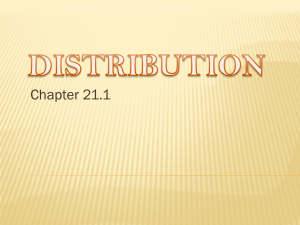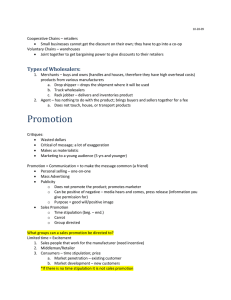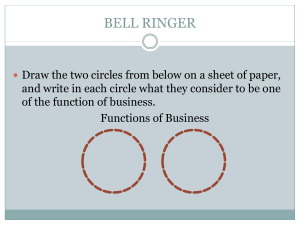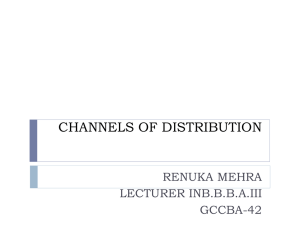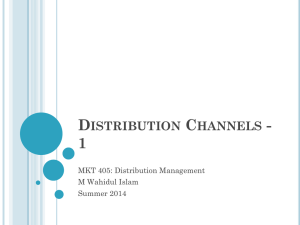New Developments in Grocery Manufacturer and Distributor Marketing Programs:
advertisement
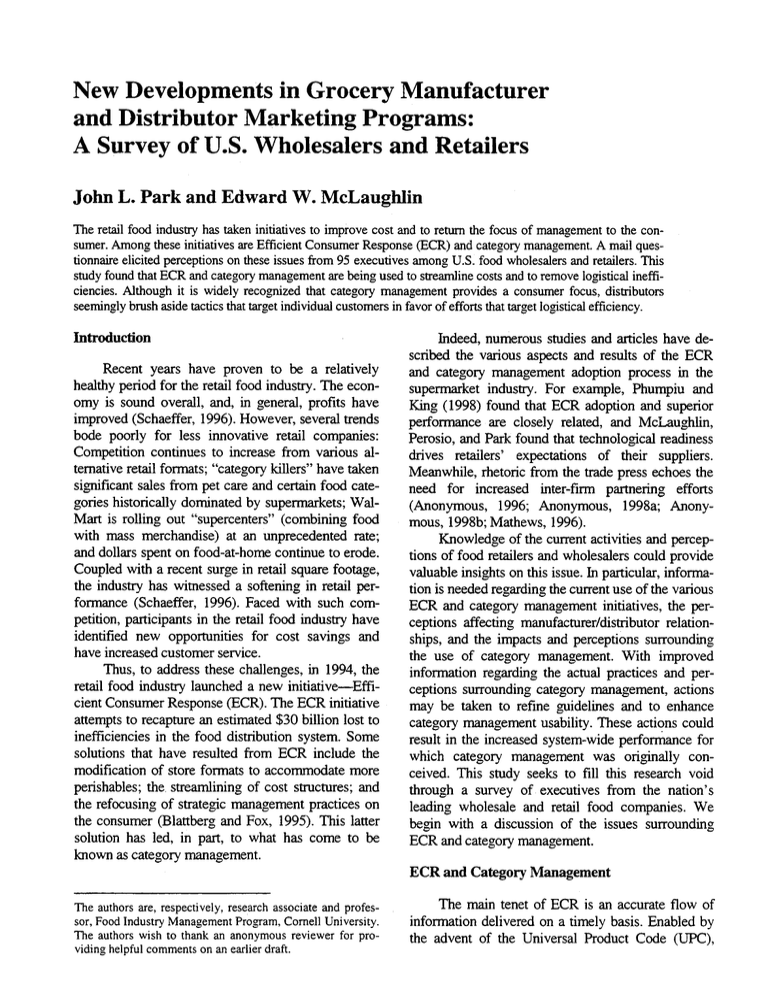
New Developments in Grocery Manufacturer and Distributor Marketing Programs: A Survey of U.S. Wholesalers and Retailers John L. Park and Edward W. McLaughlin The retail food industry has taken initiatives to improve cost and to return the focus of management to the consumer. Among these initiatives are Efficient Consumer Response (ECR) and category management. A mail questionnaire elicited perceptions on these issues from 95 executives among U.S. food wholesalers and retailers. This study found that ECR and category management are being used to streamline costs and to remove logistical inefficiencies. Although it is widely recognized that category management provides a consumer focus, distributors seemingly brush aside tactics that target individual customers in favor of efforts that target logistical efficiency. Introduction Recent years have proven to be a relatively healthy period for the retail food industry. The economy is sound overall, and, in general, profits have improved (Schaeffer, 1996). However, several trends bode poorly for less innovative retail companies: Competition continues to increase from various altemative retail formats; "category killers" have taken significant sales from pet care and certain food categories historically dominated by supermarkets; WalMart is rolling out "supercenters" (combining food with mass merchandise) at an unprecedented rate; and dollars spent on food-at-home continue to erode. Coupled with a recent surge in retail square footage, the industry has witnessed a softening in retail performance (Schaeffer, 1996). Faced with such competition, participants in the retail food industry have identified new opportunities for cost savings and have increased customer service, Thus, to address these challenges, in 1994, the retail food industry launched a new initiative-Efficient Consumer Response (ECR). The ECR initiative attempts to recapture an estimated $30 billion lost to inefficiencies in the food distribution system. Some solutions that have resulted from ECR include the modification of store formats to accommodate more perishables; the streamlining of cost structures; and the refocusing of strategic management practices on the consumer (Blattberg and Fox, 1995). This latter solution has led, in part, to what has come to be known as category management. Indeed, numerous studies and articles have described the various aspects and results of the ECR and category management adoption process in the supermarket industry. For example, Phumpiu and King (1998) found that ECR adoption and superior performance are closely related, and McLaughlin, Perosio, and Park found that technological readiness drives retailers' expectations of their suppliers. Meanwhile, rhetoric from the trade press echoes the need for increased inter-firm partnering efforts (Anonymous, 1996; Anonymous, 1998a; Anonymous, 1998b; Mathews, 1996). Knowledge of the current activities and perceptions of food retailers and wholesalers could provide valuable insights on this issue. In particular, information is needed regarding the current use of the various ECR and category management initiatives, the perceptions affecting manufacturer/distributor relationships, and the impacts and perceptions surrounding the use of category management. With improved information regarding the actual practices and perceptions surrounding category management, actions may be taken to refine guidelines and to enhance category management usability. These actions could result in the increased system-wide performance for which category management was originally conceived. This study seeks to fill this research void through a survey of executives from the nation's leading wholesale and retail food companies. We begin with a discussion of the issues surrounding ECR and category management. ECR and Category Management The authors are, respectively, research associate and professor, Food Industry Management Program, Comell University. The authors wish to thank an anonymous reviewer for providing helpful comments on an earlier draft. The main tenet of ECR is an accurate flow of information delivered on a timely basis. Enabled by the advent of the Universal Product Code (UPC), 16 July 1998 Journalof Food DistributionResearch Thus, for example, a retailer's product mix can be information transmission of this sort allows for a based on competitive environment and consumer flow of product that is paced to match consumption behavior, subject to certain category goals. Category (King and Phumpiu, 1996). Four primary activities management provides the orientation of ECR. Furform the framework of the ECR initiative-efficient ther, it brings consumer focus to a continuous effort product replenishment, efficient promotion, efficient of improvement, guiding the rationalization of prodintroductions, and efficient store assortment. uct assortment and developing new ideas to improve ECR impacts product replenishment activisales and profit (Bishop, 1997). The integration of ties by promoting a more timely, less costly flow merchandising and buying decisions represents a of products. The overall effect is a reduction of inventories throughout the food distribution sysmajor paradigm shift for retail firms, a shift from a tem. In part, this has been accomplished through buying to a selling mentality. Armed with category such practices as continuous replenishment management, retailers are now better equipped to (CRP), which relies on an improved use of data address growing competition (for example, mass between firms (King and Phumpiu, 1996). merchandisers, category killers, warehouses, and supercenters). Consumer and trade promotion activities in the A retail food company may be able to differenretail food industry are inefficient due to certain accepted industry practices. For example, the expectatiate its stores from other retail formats on its own. However, to truly segment its customer base, such tion that retailers should seek to "buy on deal" leads to artificially high prices, inefficient distribution, and companies generally need a manufacturer's guidance increased shipping and administration costs (King and assistance (Bishop, 1997). Therefore, full appreand Phumpiu, 1996). Due to the degree of inter-firm ciation of the benefits of category management recooperation required, concern over antitrust lawsong manufacturing and rerati uc c tiwes food coani prohibits the development of effective strategies to tail/wholesale food companies. Such cooperation inefficiency. reduce this reduce this inefficiency. may, at times, seem invasive to a retailer. A retailer Similarly, ECR strategies targeting new product may likely be hesitant to relinquish point-of-sale data l s g product r S new introductions are also underdeveloped. Food retailers or control of merchandising strategy to vendor partare inundated with about 19,000 potentially new ners. However, a growing body of industry evidence s . Tre UPCs (r every year 1 UPCs every year (Domblaser, 1997). Tremendous demonstrates the considerable dividends paid- by . ,, , . '. amounts of resources are seemingly wasted, includthese efforts. partneng efforts. these partnering ing product development efforts, adjustments to illustration may be useful. For one Rochesrealignment An *anagemen information systems, and management information systems, and realignment ter, New York-based retailer, Wegmans Food Marof retail shelf sets. kets, beverage category movement and profitability Finally, strategies, such as those directed tocooperation with Cocaimproved beenWfrom assortment, are among the U have supori through t (b 1P7) ward efficient store assortment, Cola USA (Zwiebach, 1997). With support from more developed strategies in the context of ECR. Coca-Cola, Wegmans shifted emphasis of ECR acBy starting with an appropriate assortment of tivities from supply-side initiatives to demand-side goods in the retail store, these efforts seek to imapplications. This allowed the retailer to focus more prove the management of product throughout the on selling and less on buying. What's more, the two food distribution system, mainly under the guise partners went beyond simple category management of category management. Because the required to customer-specific targeting. Jack Stahl, president information extends throughout the food supply of Coca-Cola USA commented: possible becomes management category chain, only through partnering efforts among food manuCategory marketing enables you to optimize a facturers, wholesalers, and retailers. category and get all the growth possible by To be more precise, the Joint Industry Project matching up how the retailer positions its on ECR defines category management as: store with customers and how we define our position ... to leverage the power of both The distributor/supplier process of managing brandnamesCokeandWegmans. categories as strategic business units, producing enhanced business results by focusing And Wegmans took advantage of the efforts as on delivering consumer value. (Blattberg and indicated by its president, Danny Wegman: Fox, 1995) Park, John L., and E. W. McLaughlin New Developments in Grocer) ... Marketing Programs 17 ... for years retailers and suppliers have each been spraying 10% of their promotional dollars to programs that can now be redirected at our best customers. Wegmans' story, while instructive, is not necessarily indicative of the industry as a whole. In a recent survey conducted by Ernst & Young LLP (1997), almost 75 percent of industry executives suggested that the industry is little improved by category management, and 25 percent said that it has failed to improve customer responsiveness. The need for more effective management of grocery categories is recognized by almost all food industry practitioners, and its overall components are agreed upon. Yet the Ernst & Young survey found that 92 percent of retailers follow only bits and pieces of the established category management guidelines. Such discrepancies in following the established guidelines may be explained by the difficulties encountered when retailers attempt to follow the guidelines in their entirety. For example, a retailer would be required to take the following actions: • · · Document category plans for more than 200 categories. Adopt a formal, collaborative, exclusive relationship with a key vendor in each category. Empower category managers with full decision making authority and profit/loss responsibility. in the United States. Thus, respondents were chosen from among the manufacturer's customer contacts. The responding sample was representative of the supermarket industry, both geographically and in frm size. The size of these companies ranged from single-store operators to many of the largest supermarket chains in the United States. Furthermore, the responding companies service retail stores coverng all 50 states. The survey elicited perceptions of a wide specru of current manufacturer sales and marketing initiatives. Ninety-five executives (51 retailers and 44 wholesalers) from approximately 56 different companies or divisions responded to the survey. In general, the individual completing the questionnaire was a senior manager, either in the merchandising or procurement area. The large and representative nature of the sample, although not predictable in a precise statistical sense, leads us to believe that our results are directionally indicative of general industry behavior. Survey Results Executives were asked to prioritize the primary ECR activities (replenishment, promotion, new product introductions, and assortment) for their companies and to indicate the degree to which they are currently implemented (Table 1). On average, re- spondents rate Efficient Replenishment activities as having the highest priority within their company, with Efficient Promotion activities rated as the second highest priority. Yet, when looking at the degree • to which these activities have been implemented, the · number one priority (Efficient Replenishment) is not as fully implemented, on average, as the number two priority (Efficient Promotion). Moreover, all four such WithWith such disparities disparities between between recommend recommended , ECR initiatives have been less than 50 percent imc y actual fr practices and actual practices for category management, the plemented by U.S. retailers. 7r and.D, ,D °c question is raised as to the actual status of manufacResults show that by the end of 1995 the majorturer and distributor marketingDprograms. To• answer .ity of grocery cd a ° D r companies had adopted ate at least a few this question, we turn to a survey of executives from r management (Table 2). In fact, aspects of ccategory ~ -i'~ . .. TT^I J , U.S. wholesale and retail food companies. U.S. wholesalead rl fd all of the surveyed executives indicated that category management was (at the very least) an important Food Executive Survey consideration for their companies. However, only 22 percent of retailers and 9 percent of surveyed wholeA mail questionnaire was sent to senior-level salers indicated that category management is fully food executives from approximately the leading 200 integrated and operational in their companies. grocery wholesale and retail companies in the United Fifty-four percent of wholesalers and retailers States. The survey was collected in spring 1996. indicated that the manufacturer's primary role in Distribution of the survey was accomplished with the category management was to provide information on aid of a major national food manufacturer whose the market, consumers, or both (Table 3). operations and representatives service every market • responsiblit. purely loss Reaking Relegateauthrity buying toana purely logistical role. in a continuous Costing Based Activity Employ management process. Integrate price, mix, promotion, and space decisions in support of category strategies. Totally integrate the data management environment. Journalof FoodDistributionResearch 18 Jul, 1998 Table 1. Priority and Implementation of ECR Initiatives. Priority ECR Initiative Degree of Implementation Efficient Replenishment Mean Scorea 3.40 (1 0 0 )b 37 78 3.2 3(2 (0.75) 2.7 ) ( 37 Efficient Store Assortments (1.01) 1.8 (8) 33 Efficient Product Introductions (0.98) Initiatives were scored as to the importance to the responding company (l=lowest priority, 4=highest priority). bStandard deviations are presented in parentheses. Efficient Promotion % Scoring 3 or 4 45 79 48 22 Table 2. Status of Category Management, 1996. Status Category management is not considered an option for our company. Category management is being considered, but there has been no experimentation. Experimentation has begun, but it is too early to judge results. Experimentation is under way, but category management is not integrated into daily operations. Experimentation is complete and category management is operational for some categories. Experimentation is complete but category management is not operational in all categories. Category management is fully integrated and operational. Percent Responding Wholesalers Retailers 0 0 2 4 11 18 27 27 22 43 7 22 9 Table 3. Distributor Perceptions of the Primary Category Management Role of Manufacturers. Potential Role Provide and/or interpret market information Analysis and technical support Provide detailed customer information Strategic planning Other Twenty-seven percent of distributors desired analysis and technical support from their manufacturing partners. Only 10 percent of those who were surveyed suggested that manufacturers should assist in strategic activities. Wholesalers and retailers were asked to indicate the degree to which they use demographic and customer-specific data (Table 4). In general, retailers appeared consistently more involved than wholesalers in this area. Also, more than 50 percent of wholesalers and retailers indicated that they employ different media to reach different customer segments. Finally, retailers seemed more involved with micro- Percent Responding 38 27 16 10 8 marketing done without the support of a manufacturer partner. Forty-nine percent of retailers indicated that their companies used such methods, while only 29 percent indicated that they conducted such activities in cooperation with manufacturers. In general, grocery manufacturers charge a single list price for an individual product (corresponding to a specific UPC), regardless of the customer. In fact, with several exceptions dictated by the Robinson-Patman Act (for example, differences due to transportation or for special packs that may be available at select types of retail outlets), they are legally required to do so. Park, John L., and E. W. McLaughlin New Developments in Grocery ... Marketing Programs 19 Table 4. Use of Demographic and Customer-specific Data. Percent Responding Retailers Use of Customer-specific Dataa Wholesalers Not used at all. 0 2 Have begun to collect ourselves, but have not used yet. 4 18 Have experimented a few times. 25 34 Have classified customers into meaningful segments based on past purchase patterns. 43 25 Conduct regular micro-marketing activities under our own supervision, without manufacturer support. 49 31 Conduct regular micro-marketing activities with support from manufacturing partners. 29 25 Employ different media to reach individual customer segments. a Responses are not mutually exclusive. 57 52 However, the price given retailer A could be legaily different from that of retailer B if the manufacturer were to price its products according to the actual costs of doing business with either company A or B. When asked their view on this approach, 66 percent of wholesalers and retailers indicated that they prefer this latter system, while 31 percent indicated that they prefer "one price for all," and the remaining 3 percent indicated no preference. When asked to indicate the various impacts of category management (Table 5), the one most often cited was reallocation of shelf space within specific categories (91 percent). Furthermore, 88 percent of respondents indicated that the adoption of category management has had the effect of reducing the number of SKUs in a category, and 72 percent indicated an increase in the variety of brands, sizes, or forms of products within categories. Other impacts of category management received relatively less attention. Sixty-five percent of respondents indicated that category management has allowed their companies to cluster stores for targeted advertising, promotion, or merchandising, and only 45 percent indicated that it has allowed them to manage customer dynamics. Table 5. Impacts of Category Management Perceived by Wholesale/Retail Food Companies. Perceived Impact Percent Responding Reallocated shelf space within categories with new plan-o-grams. 91 Reduced the number of "duplicate" SKUs in a category. 88 Strengthened private label performance. 80 Reallocated store space among categories. 73 Increased the variety of brands, sizes, or forms of products within categories. 72 Clustered stores for targeted advertising, promotion, or merchandising. 65 Optimized retail pricing. 63 Improved management of trade promotions and displays. 62 Improved management of customer dynamics. 45 Journalof Food DistributionResearch 20 Jul 1998 Distributors were asked to indicate the percent of impact that category management had had on their business in 1995 and to project what those impacts would be in the year 2000 (Figure 1). Responses varied only slightly between wholesalers and retailers, the most prominent difference being the perceived impact of category management on turnover. Retailers indicated that category management had already increased turnover by 13.3 percent in 1995 but forecast that this would likely increase to 26.2 percent by the year 2000. Wholesaler indications were slightly lower, with category management increasing turnover by only 7.8 percent in 1995 and 19 percent by the year 2000. Both wholesalers and retailers perceived that category management had as large an impact on cost savings as on increased sales. Consequently, it is not surprising that respondents also perceived that category management would produce a significant increase in net bottom line (from 14.9 percent as indicated by wholesalers to 16 percent as indicated by retailers) by the year 2000. Also, customer service was perceived to show great improvement due to category management in the coming years. Wholesalers and retailers seemed to agree on the greatest constraint to implementing cooperative activities with their suppliers. Twenty-eight percent of retailers and 33 percent of wholesalers (Table 6) indicated that the lack or inadequacy of technical resources impedes implementation of co-marketing programs. The next constraint most often indicated by wholesalers (another 33 percent) was a lack of cooperation between wholesalers and retailers, yet only 2 percent of retailers indicated this constraint. Figure 1. Perceived Impacts of Category Management. Retailers Wholesalers •2000 1019953 14.1 14.1 02000 14.9 ost savings _Increase 5.1 1 12.9 11.5 11.6 __ Decrease in new product introductions 7.3 1 Improvement in customer service 7.8 1 Increase in turnover 19.9 19.0 10% 16.0 4.8 increase _Sales 3.9 20% 1"B2000 11.5 40 _ in net ebottom line (EBIT) 14.1 30% _ _ 5.4 0% 16.1 1 5.9 21.5 7.2 26.2 13.3 0% Percent Impact 10% 20% 30% Percent Impact Table 6. Constraints to Development of Co-Marketing Programs. Constraint Technical resources Inability to evaluate co-marketing programs Company structure, identity, or culture Customer relations Time and/or personnel Wholesaler-Retailer cooperation Other Percent Responding Wholesalers Retailers 33 28 0 15 9 13 2 13 5 9 33 2 19 20 Park,John L., and E. W. McLaughlin New Developments in Grocer),... Marketing Programs 21 Discussion of Results Efficient Replenishment was identified by our industry respondents as being the highest priority among ECR activities. This is in accord with other reports on ECR and category management, indicating that the initiatives have been primarily used to improve efficiency and to remove costs from the system (Ernst and Young LLP, 1997; Zweibach, 1997). And yet, activities associated with Efficient Replenishment are not as fully implemented, on average, as the number two priority, Efficient Promotion. Perhaps this is an indication that wholesale and retail companies feel relatively secure in their promotional activities but recognize a vast potential for improvement in optimizing the cost and time of replenishment. As indicated by a recent study by Andersen Consulting, retailers may be faced with more imminent problems like out-of-stock merchandise. Thus, while category management may seem to prescribe a consumer focus, distributors must face immediate needs for improved replenishment on an everyday basis. By 1996, at least some aspects of category management were adopted by the majority of grocery companies. Although 22 percent of retailers and nine percent of wholesalers indicated that category management is fully functional and integrated into their company (Table 2), a more substantive statement is that no retailers or wholesalers indicated a complete lack of category management in their companies. In fact, the survey shows that approximately one-half of retailers and wholesalers have completely implemented category management for at least some categories. This is in support of many other observations that category management, at least in elemental form, is accepted practice among contemporary wholesalers and retailers. However, the core notion of category management revolves around distributor-manufacturer cooperation. It even mandates such partnerships. Yet upon examination of Table 3, we see that distributors want their manufacturing partners to have little to do with strategic planning. In fact, they would prefer to relegate manufacturers to an informational role at best. While previous surveys (McLaughlin and Hawkes, 1994) have shown that retailers and wholesalers feel that they are more enthusiastic about category management than their manufacturing counterparts are, it could be that manufacturers are more disgruntled with the role that they are expected to play than with category management itself. Another example of the differences in marketing activities of wholesalers and retailers lies in their use of demographic and customer-specific data. Retailers show themselves to be consistently more involved in these activities than wholesalers do (Table 4). And yet, only 29 percent of retailers and 25 percent of wholesalers indicated that they conduct these activities with manufacturer support. Overall, the survey indicates an industry with participants somewhat evenly divided by the degree to which customer-specific data is used. If developed as envisioned by its industry architects, category management can have farreaching impacts on the structure and behavior of the retail and wholesale grocery industry. In general, our survey indicated that category management has already had the effect of reducing SKUs while increasing the variety of brands, sizes, or forms of products within categories (Table 5). This apparent contradiction reflects that some categories may be overburdened with "duplicate" SKUs, and others may have room for an expansion of SKUs. Regardless, category management will have the effect of optimizing the mix of SKUs within individual categories. Instead of a retailer having, say, three brands of mustard, after application of category management, the retailer may carry only two brands, reducing the number of SKUs within the category. At the same time, the retailer may add SKUs that increase the variety or package size and still have a net reduction in category SKUs. Thus, retailers feel that a reported reduction in SKUs does not necessarily imply a loss of choice by consumers. On the contrary, it is perceived that the variety of products from which to choose will presumably reflect an optimized basket of goods targeted toward consumers in a particular market. This is in agreement with the ProgressiveGrocer survey (Schaeffer, 1996), which found that category management was named the most important ECR activity among chain executives and wholesalers; those surveyed by Progressive Grocer also indicated the importance of stressing efficient assortment. As industry participants have become familiar with category management, their tactic has evolved from streamlining the category to efficient customization of the category. While the adoption of category management is intended to be a more efficient alternative to traditional purchasing and merchandising methods, its overall effectiveness is difficult to assess. Certainly, as category management is further integrated into the Journalof Food DistributionResearch 22 Jul) 1998 daily activities of individual companies, corporate effectiveness should increase. This reasoning is refleeted in the perceived impacts that category management has had on various corporate measures of performance (Figure 1). For example, retailers in our survey indicated that category management practices increased sales by 5.1 percent in 1995. By way of comparison, the 1996 Progressive Grocer Annual Report (Schaeffer, 1996) identified an overall supermarket sales increase of 3.6 percent, and supermarket chains (vs. independent retailers) reported an increase in sales of 7.3 percent. Thus, the 5.1 percent sales increase that is indicated by retailers in our survey is certainly plausible. By the year 2000, however, food retailers expect more than an 11 percent increase in sales attributable to category management. In terms of the $311.7 billion of U.S. supermarket sales witnessed in 1995, this increase would represent more than $36 billion of incremental sales attributed to the integration of category management practices by the year 2000. Similarly, retailers in our study reported that category management had positive impacts on EBIT. In fact, the 4.8 percent impact that retailers attributed solely to category management represents about one-third of the actual growth in industry EBIT between 1994 and 1995 (Food Marketing Institute, 1996). As indicated by our survey, food distributors are optimistic about the potential gains in profitability due to the inception of category management. Retailers also perceive category management as having other significant impacts on their operations. Assuming a large supermarket chain will turn inventory about 16 times per year (see Food Marketing Institute, 1996, for detailed tabulations on various productivity results for U.S. retailers), our survey indicates that category management alone will raise inventory turns to roughly 20 times annually by the year 2000. In addition, category management is per- wholesalers was a lack of cooperation between wholesalers and retailers; very few retailers indicated this constraint. This difference, of course, is expected, given the degree of control that retail chains are able to exert on their own corporate stores. On the other hand, retailers seem concerned with their ability to properly assess the wealth of information to be gained from such programs. Concluding Remarks To summarize, competition and concentration in the retail food industry have intensified. In response, the industry has taken initiatives to improve cost and return management focus to the consumer. Efficient Consumer Response and category management are two examples of this. Our survey indicates that distributors understand the potential benefits that these initiatives offer, yet their actual practices fail to reflect this understanding. ECR and category management are being used primarily to streamline costs and to remove logistical inefficiencies. Tactics that target individual consumers are seemingly brushed aside to make way for efforts that target logistical efficiency with readily obtainable results. A buyer, or procurement, mentality still prevails among many grocery merchandisers. But, as distributors improve their technological ability, it is likely that they will attempt to shift that focus to a selling mentality and beyond into targeted, customerspecific marketing. Indeed, a few leaders are doing so already. Increased trust and partnerships with manufacturers will be instrumental in achieving this goal. The innovative will take advantage of this potential, thrusting their businesses to new levels of efficiency, improved services, and consumer satisfaction in the next century. References Reerences Anonymous. 1996. "Improved Inventory Management: The New Strategic Imperative." Chain Store Age. 72:Section 2. 22,572 items in 1995 to an estimated 18,938 items in . 1998a. "ECR Means Huge Prizes for Some." Intemathe year 2000. Journal of Retail & Distribution Management. tional discusof the g understa Finally, a greater Finally, a greater understanding of the discus-26132-133 . 1998b. "Study Says Manufacturers Hurt Themselves." sion thus far may come from an examination of the Supermarket Business. 53:10. constraints that wholesalers and retailers face as they Consulting. 1996. The Retail Problem of Out of Stock Andersen implement these new initiatives. Wholesalers and Merchandise. Coca-Cola Retailing Research Council Reretailers agreed that the greatest constraint to impleport, The Coca-Cola Company. Company. menting cooperative activities with their suppliers is of Efficient Consumer Response 1997. "Impact W.R.Coca-Cola Jr., The Bishop,port, of Food Distribution Research. Journal Marketing." on the lack or inadequacy of technical resources; howceived to decrease new product introductions 16.1 percent by the year 2000, representing a change from ever, the next constraint most often indicated by 28:21-25. Park, John L., and E.W. McLaughlin New Developments in Grocer)y... Marketing Programs 23 Blattberg, R.C., and E.J. Fox. 1995. Category Management: Getting Started. Washington, DC: Food Marketing Institute. Domblaser, L. 1997. "New Product Totals." New Product News. January 9. Ernst & Young LLP. 1997. "Category Management: Fact or Fiction?" Progressive Grocer 76:1 a-30a. Food Marketing Institute. 1996. The Food Marketing Industry Speaks, 1996. Washington, DC: Food Marketing Institute. King, R.P., and P.F. Phumpiu. 1996. "Reengineering the Food Supply Chain: The ECR Initiative in the Grocery Industry." American Journal of Agricultural Economics. 78:1181-1186. Mathews, R. 1996. "Lifeblood or Tired Blood?" Progressive Grocer. 75:24-28. McLaughlin, E.W., and G.F. Hawkes. 1994. "Category Management: Current Status and Future Outlook." Ex- tension Bulletin #94-28, Department of ARME, Cornell University. McLaughlin, E.W., D.J. Perosio, and J.L. Park. 1998. "Retail Logistics and Merchandising in the USA: Current Status and Requirements in the Year 2000." International Journal of Retail & Distribution Management. 26:97-105. Phumpiu, P.F., and R.P. King. 1998. "Efficient Consumer Response Adoption at the Store Level." In Proceedings of the Third International Conference on Chain Management in Agribusiness and the Food Industry. G.W. Ziggers, J.H. Trienekens, and P.J.P. Zuurbier, eds. The Netherlands: Wageningen Agricultural University. Schaeffer, L., ed. 1996. 63rd Annual Report of the Grocery Industry. Stamford, CT: Progressive Grocer Associates. Zweibach, E. 1997. "ECR Shift Hiked Wegman's Beverage Profit." SupermarketNews. 47:4, 91.

